Adobe Pushes More Powerful Features to Elements Packages
Adobe released version 11 of Photoshop Elements and Premiere Elements on Tuesday (25 Sep). I've been working with them for a few weeks. A decade ago, the Elements applications were elementary in scope but over the years they've become more and more powerful—not so powerful that they will steal market share from Photoshop or Premiere, but still packed with features that will appeal to photo and video enthusiasts.
With each new version of Elements, Adobe adds features that were once limited to the professional product line as the professional products continue to push forward into new areas. Product Manager Bob Gager describes the rationale behind this continued push of new features ...
Let's take a look at Photoshop Elements 11.
Click any of the smaller images for a full-size view.
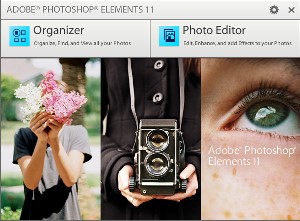 When you open Photoshop Elements or Premiere Elements, you'll be offered the choice of going directly to the editor or starting with the organizer. My recommendation would be to choose the organizer.
When you open Photoshop Elements or Premiere Elements, you'll be offered the choice of going directly to the editor or starting with the organizer. My recommendation would be to choose the organizer.
As an aside, notice the twin-lens-reflex camera in the middle panel of the splash screen. These cameras gave photographers bargain-basement access to medium-format film. The images were square (6cm by 6cm or 2¼x2¼ inches). Because the viewing lens and the "taking" lens were separate, there was a parallax problem but these cameras could provide outstanding quality at an affordable price. Perhaps that's why Adobe selected this image.
 The Organizer provides access to all of the images you have on the computer and makes it possible to import images from a digital camera.
The Organizer provides access to all of the images you have on the computer and makes it possible to import images from a digital camera.
When you're ready to work on a photo, you can select it, right-click and choose to open it in Photoshop Elements. I selected an image from those that I made at the Northland Independence Day Parade, the only parade held in Columbus on the 4th of July and the largest privately organized parade in Ohio.
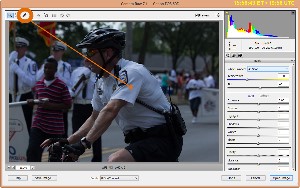 Because the image is a raw file, it opens first in Adobe Camera Raw. The Columbus police officer on the bicycle is wearing a white shirt, so I selected the white-balance tool and clicked the shirt to correct the color balance.
Because the image is a raw file, it opens first in Adobe Camera Raw. The Columbus police officer on the bicycle is wearing a white shirt, so I selected the white-balance tool and clicked the shirt to correct the color balance.
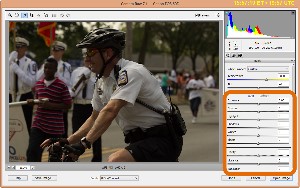 With the color correct, I decided to use some of the other Camera Raw controls to improve the image before opening it in Photoshop Elements.
With the color correct, I decided to use some of the other Camera Raw controls to improve the image before opening it in Photoshop Elements.
 The image needed to have the blacks and shadow areas opened up a bit. I also boosted both clarity and contrast a bit and then clicked the Open button.
The image needed to have the blacks and shadow areas opened up a bit. I also boosted both clarity and contrast a bit and then clicked the Open button.
 Photoshop Elements has 3 editing modes: Quick (the easiest option), Guided (with more choices but still easy), and Expert (the right choice for those who know what the various controls do or for those who want to review what one of the other modes has done.)
Photoshop Elements has 3 editing modes: Quick (the easiest option), Guided (with more choices but still easy), and Expert (the right choice for those who know what the various controls do or for those who want to review what one of the other modes has done.)
Let's say that I'd like to create a "Golden Hour" effect. Here I've selected Balance and I've selected an option that will warm the image. Although I took this photo in the early afternoon, it now appears to have been created around sunset.
 In Expert Mode, you'll see controls on the left that look a lot like what you'll find in Photoshop and, on the right, you'll see the layers.
In Expert Mode, you'll see controls on the left that look a lot like what you'll find in Photoshop and, on the right, you'll see the layers.
In this case, there's only one layer so let's do something that will add some layers.
Let's say that I'd like to convert the image from a modern 2012 color photo to one that looks like it had been taken in the early 1960s.
 I selected Guided options and then Old Fashioned Photo. Note the choices along the right side of the image to convert the photo to monochrome, add texture, and modify the hue and saturation.
I selected Guided options and then Old Fashioned Photo. Note the choices along the right side of the image to convert the photo to monochrome, add texture, and modify the hue and saturation.
So I worked through the various options.
 Here's the result. Photoshop Elements created 2 additional layers. The top layer includes my most recent changes. But this is a monochrome image and I said that I was looking for something that would look like a 1960s color photograph.
Here's the result. Photoshop Elements created 2 additional layers. The top layer includes my most recent changes. But this is a monochrome image and I said that I was looking for something that would look like a 1960s color photograph.
That's where the layers are important.
 Here I've turned off the middle layer and have reduced the opacity of the monochrome layer on top so that some of the color from the background will show through.
Here I've turned off the middle layer and have reduced the opacity of the monochrome layer on top so that some of the color from the background will show through.
 And this is the final image. There's enough grain and the color has been sufficiently muted that it looks like an image from the 1960s.
And this is the final image. There's enough grain and the color has been sufficiently muted that it looks like an image from the 1960s.
Giveaways that it isn't a photo from the 1960s: The communications gear and helmet that the police officer is wearing. Probably there are other clues but the quality of the photograph isn't one of them. It really looks like something from the 1960s.
I'll take a look at Premiere Elements in a future program.

 Photoshop Elements Offers Power and Ease of Use in an Affordable Package
Photoshop Elements Offers Power and Ease of Use in an Affordable Package
Photoshop Elements continues to evolve and, as Adobe pushes high-end features from earlier versions of Photoshop down to Photoshop Elements, this inexpensive application becomes an even better value. Although this is not the application that photo professionals will want, Photoshop Elements provides everything the photo enthusiast could want and more. According to Adobe, Adobe Photoshop Elements 11 and Adobe Premiere Elements 11 for Windows and Mac is available from the Adobe website and will soon be available at retail outlets. The package that includes both costs $150 (upgrade price $120) and the individual products are available for $100 each (upgrade price $80).
For more information, visit the Photoshop Elements website.
Learn Almost Anything Online (Sometimes for Free)
Are Salman Khan and Bill Gates trying to put universities out of business? Maybe not but that could be the unintended consequence of Khan Academy. Several years ago, Salman Khan was an analyst at a hedge fund and he was working with his cousins to explain mathematics. He prepared some videos that he posted to YouTube so that his cousins could review them but others found them and found them useful. Hmmm. This is profound.
A co-worker from Austin asked if I'd ever heard of Khan Academy. I hadn't but he was so emphatic about it that I decided to check it out.
In a TED Talk, Kahn explained the way the typical classroom works: "Imagine learning how to ride a bicycle and I give you a bicycle. Maybe I give you a lecture ahead of time. I give you that bicycle for two weeks and then I come back and I say, 'Let's see, you're having trouble making left turns and you can't quite stop. You're an 80% bicyclist. So I put a big 'C' stamp on your forehead and then I say 'Here's a unicycle.'" As absurd as that sounds, that's exactly what's happening today in classrooms from kindergarten to postgraduate medical classes.
What's different about the Khan Academy (other than the fact that it's provided for free) is that it expects perfection. You can't move forward to the next topic until you've demonstrated that you fully comprehend the current topic. This eliminates what Khan calls the "Swiss-cheese gaps" that cause even intelligent students to fail once they've built up enough gaps in the information they have to work with.
See Salman Khan's TED Talk from 2011:
Logic, computer programming, genetics. These are just a few of the topics that Khan Academy provides. But there are also programs on science (biology, chemistry, medicine, physics), computer science (programming, animation), finance (valuation and investing, venture capital, banking and money, currency), humanities (history, civics, art history), and even preparation for tests (SAT, GMAT, and more).
I mentioned Bill Gates previously. It seems that his kids found these videos and Gates has invested in the program. In the TED talk, Gates says "I think you've just got a glimpse of the future of education."
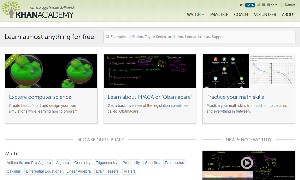 Anyone can watch any video. If you understand the topic, you can become a coach. Teachers are offered a link that will provide a toolkit so that they can use Khan Academy in the classroom. And currently some 3400 videos exist on the site.
Anyone can watch any video. If you understand the topic, you can become a coach. Teachers are offered a link that will provide a toolkit so that they can use Khan Academy in the classroom. And currently some 3400 videos exist on the site.
I decided to work my way through the Mathematics tree, which starts with "Arithmetic and Pre-Algebra". The first set of topics were "Addition and subtraction", "Multiplication and division", "Negative numbers", "Number properties", "Order of operations", "Factors and multiples", "Fractions", "Decimals", "Percents", "Ratios and proportions (basic)", and "Exponents (basic)". Each of those topics includes a dozen or more sub-topics.
This is the first math exercise (basic addition): http://www.khanacademy.org/math/arithmetic/addition-subtraction/v/basic-addition
After quickly proving that I had mastered basic single-number addition, I was offered several options and I decided to move forward with multiplication and division. The questions were anything but basic. They ranged from number problems to more complicated word problems and I realized that I had forgotten the differences between associative, commutative, and distributive properties of operations.
For those who, like me, have forgotten the definitions of associative, distributive, and commutative properties (even though we will apply the principles properly). Note that != means "does not equal".
7+(4+3)=(7+4)+3 - associative - the order of operations doesn't matter. Addition and multiplication are commutative but subtraction and division are not: 7-(4-3) != (7÷4)÷3 and 7÷(4÷3) != (7÷4)÷3.
2×(1+3)=(2×1)+(2×3) - distributive - applies only to multiplication: 2÷(1+3) != (2÷1)+(2÷3), 2+(1+3) != (2+1)+(2+3), and
2-(1+3) != (2-1)+(2-3).
1+2=2+1 - commutative - terms may be reversed. Addition and multiplication are commutative. Subtraction and division are not: 1-2 != 2-1.
And next week I probably won't remember the various properties by name but I'll continue to use them properly in practice!
Other Online Options for Free Learning
Some universities are offering free online courses through Coursera, a California company. Recently 17 more domestic and international universities have joined the online network. The additions advance the number of institutions offering courses through Coursera to 33, one of several new companies offering free cyber courses from elite universities. Coursera now offers more than 200 courses open to anyone with an Internet connection.
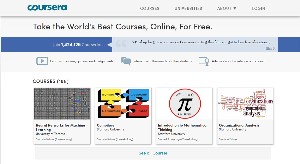 Sites that provide massive open online courses (MOOC) are changing higher education for those who aren't interested in earning a diploma. Coursera's partners include Brown, Columbia, Emory, Vanderbilt, and Wesleyan universities, Hebrew University of Jerusalem, (the) Ohio State University, University of Michigan, Johns Hopkins University, Illinois University, University of British Columbia, University of London, the Hong Kong University of Science and Technology, and many more.
Sites that provide massive open online courses (MOOC) are changing higher education for those who aren't interested in earning a diploma. Coursera's partners include Brown, Columbia, Emory, Vanderbilt, and Wesleyan universities, Hebrew University of Jerusalem, (the) Ohio State University, University of Michigan, Johns Hopkins University, Illinois University, University of British Columbia, University of London, the Hong Kong University of Science and Technology, and many more.
Not all programs are available at all times here. You will need to wait for the class to be offered at the university so it's more like attending class on-campus than at Khan Academy. In effect, you're auditing the class, which means that you receive no credit for taking it but if your primary goal is to learn something and not necessarily to earn a degree, this is the way to do it.
Not Free But Valuable
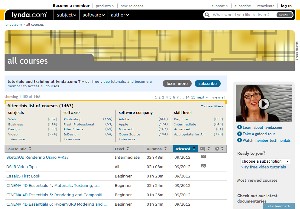 I consider Lynda.com to be one of the most valuable fee-based educational sites on the Web. Although the site has a heavy emphasis on video, still images, and website development, the offerings have expanded in recent years to include accounting, career development, marketing, pod-casting, social media, time management, and more.
I consider Lynda.com to be one of the most valuable fee-based educational sites on the Web. Although the site has a heavy emphasis on video, still images, and website development, the offerings have expanded in recent years to include accounting, career development, marketing, pod-casting, social media, time management, and more.
The production techniques have improved, too. When a presenter can make a better presentation by appearing on screen, the production system can accommodate that person and most of the presentations come with sample files that, depending on your subscription type, can be downloaded so that you can work along with the on-screen presentation.
Individual segments that are rarely more than 7 to 10 minutes long each covers a specific topic (Shooting by Candle Light, for example) within the overall presentation (in this case, Ben Long's Foundations of Photography: Night and Low Light series.
Short Circuits
A Replacement for IGoogle?
You probably already know that IGoogle's portal will not be available after 1 Nov 2013 so you still have more than a year to find a replacement if you want one. I like having a page that provides useful information so an ad on the IGoogle page that suggested IGHome looked interesting. Have you seen it yet?
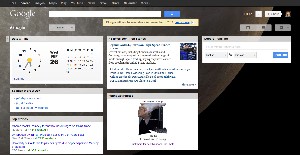 Next year we won't be able to use IGoogle.
Next year we won't be able to use IGoogle.
The link to IGHome showed me a basic page. I was taken aback to find the Drudge Report on the home page. If you want to attract me, this is not the way to do it and let's just leave it at that. But I signed up anyway and immediately deleted the Drudge Distortions. Then my page contained Yahoo Sports (boring), AccuWeather, Business Insider (never heard of it), Date and Time, Lifehacker, Pinterest, and Flixster.
Before looking to see what other items were available, I wanted to re-arrange what was there. Positioning items is flakey to say the least. I wanted to place the AccuWeather radar under the forecast but couldn't. I'd drop it under the weather and it would move elsewhere.
Adding gadgets offers Categories and Local News. Columbus is included so I selected the Dispatch and Business First. The National Weather Service has a widget, so I dropped AccuWeather and AccuWeather Radar. News offerings are currently limited to Drudge (blecch!), CNN, Fox (blecch!), USA Today Tech Stories, and MSNBC. I picked CNN as the most reliable of the available offerings.
Science and Technology offered Lifehacker (already on my page), National Geographic, Endadget, CNET, and Popular Science. I added all of them. Then I noticed Information Week, Wired, and Gizmodo and added them, too. You'll also find NASA (added), GigaOM, Scientific American (added), Crunch Gear (added), and several more.
 Needless to say, there are lots of options in the Political category.
Needless to say, there are lots of options in the Political category.
Moving on to International News, I found the BBC, Jerusalem Post, Irish Times, The Sun (UK), and France24. I added all but The Sun. Additional news offerings include USA Today (added), ABC News, CBS News, Washington Times, and Time (added). Oddly, if you want the New York Times, you'll need to visit the NYC regional page.
Mike Sutton, the creator of IGHome says "As you know, iGoogle is going away. But, there are many people that still enjoy the convenience of a personalized home page. My name is Mike and I'm the owner of igHome.com. It is currently in the beta phase, so we'll be making changes quite frequently--adding new features and gadgets. If you have any suggestions, or can't find a gadget that you really need, let me know. Just reply to this email, and I will get back to you as quickly as possible."
I reported what I thought was a problem to Mike and had a response from him just minutes later. As it turned out, the "problem" was something I had set up incorrectly. This is an application to watch and I hope that it will turn out to be exactly the right replacement for IGoogle. The next challenge will be how to monetize it because I suspect that it's going to be popular.
You Don't Want One (Yet) But You Might
This week, California Governor Jerry Brown hopped into a car and it drove him to Google headquarters where he signed a bill making driver-less vehicles street legal in California. You might think California leads the nation in this area, but it's the third state to approve driver-less cars. The other two are Nevada and Florida.
The law doesn't call them "driver-less cars"; instead they're "autonomous vehicles" and the law specifies safety and performance requirements for them.
You don't want an autonomous vehicle just yet, though, for at least 2 reasons: First the onboard electronics will take up most of the storage space. Second, the onboard electronics will make the cars prohibitively expensive. And, if you need a third reason, the exterior sensors make them look goofy.
But the day is coming.
As Brown signed the measure into law, one reporter asked who gets a ticket if the autonomous vehicle runs a red light. Brown said they'd have to figure that out but the chances are good that an autonomous vehicle won't run a red light. Google's test cars have driven nearly half a million miles (480,000) without causing a wreck, although one was rear-ended.
Autonomous vehicles could be used by people whose eyesight is too bad to qualify for a license or by people who are intoxicated.
We already have airplanes that are largely autonomous and some trains are autonomous, so why not cars? There are questions, of course. Although Google's test fleet has never caused a collision, it's certain that one will someday. The programming will have a hidden flaw or something will break. What are the legal ramifications? Who (if anybody) gets sued? This is clearly an extension of the who gets a ticket if the car runs a red light question.
The new California law provides $5,000,000 worth of insurance during testing and the law specifies that a licensed driver must always be in a position to take over immediately if something goes wrong, just as airplanes still have pilots even though they can take off, navigate from one point to another, and land with no human intervention as long as nothing goes wrong.
Windows 8: Coming in Less than One Month
Some of the manufacturers are showing off the gear that they'll release with the new version of Windows and some are even talking about prices.
Lenovo, for example, is talking about an $800 tablet that comes with a keyboard. The tablet will have a 1366x768 pixel screen and Lenovo says it should run for about 10 hours on a full battery charge.
The ThinkPad Tablet 2 will include full version of the Office 2013 productivity suite. A less expensive model will run Windows 8 RT and will sell for less than $600. The price for this model hasn't yet been made public but figures as low as about $300 have been mentioned.
Meanwhile, over at Intel, CEO Paul Otellini, who publicly supports Windows 8, has reportedly told Intel staffers that the new operating system isn't ready. Otellini is said to have made that statement in a visit to Intel's Taipei operation.
To add a third side to this multi-dimensional story, Otellini is reported to have said that releasing the operating system now is the right thing to do and that improvements will simply have to be added later.
But isn't that the way that Microsoft always works? A new product comes to market with certain deficiencies and these are later corrected with service packs. Actually, that's the way most operating systems and software work.
Windows 8 will be generally available on October 26th.



 The author's image: It's that photo over at the right. This explains why TechByter Worldwide was never on television, doesn't it?
The author's image: It's that photo over at the right. This explains why TechByter Worldwide was never on television, doesn't it?
